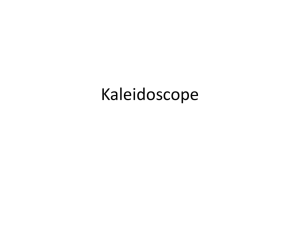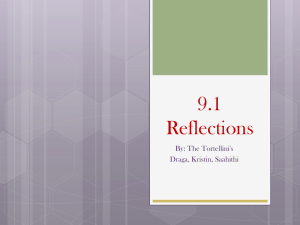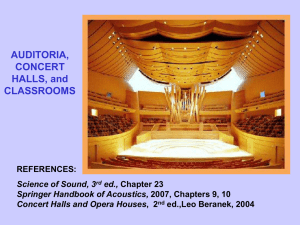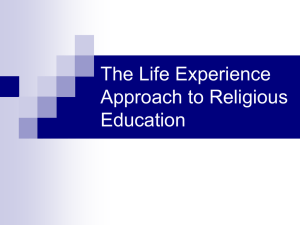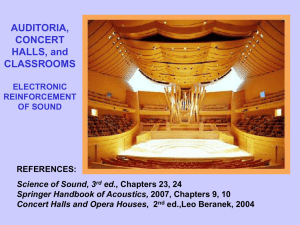PowerPoint File - uri=ettl.edc.polyu.edu
advertisement
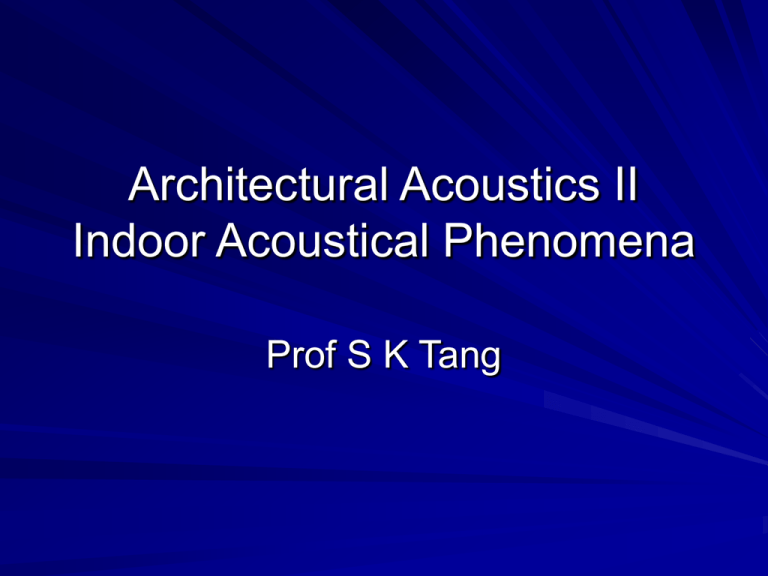
Architectural Acoustics II Indoor Acoustical Phenomena Prof S K Tang Preface Concepts on direct and reverberant sound fields and reverberation time have been introduced in past years Direct sound follows inverse square law Reverberant field is uniform (ideal case) Enclosure has acoustic response Human responses to sound is subjective – psychology & physics Acoustic Responses of Enclosure Similar to a mechanical & electrical system, an enclosure responses to acoustic excitation Impulse decay g(t) – impulse response function g includes information of direct sound, reflections and the amount of room absorption These responses then modify the direct acoustical signal and contribute directly to human responses Modulated acoustic signal is heard Psycho-acoustics Consideration Reflections cannot be avoided A mixture of direct sound and reflections reaches human ears How these reflections are perceived? Two questions to deal with : Psycho-acoustics Consideration Under what condition is a reflection perceivable at all, without regard to the way in which its presence is manifested, and under what condition is it masked by the direct sound? Under what condition does the presence of a reflection rate as a disturbance of the listening impression? Absolute Perceptibility function of the time delay of the reflection The threshold also depends on type of sound For a sound of 70dBA and frontal incidence : L 0.6to 8 Human is more sensitive to reflections arriving from lateral directions Threshold of absolute perceptibility for speech Threshold of absolute perceptibility for music Our hearing is less sensitive to reflection when music is concern Echoes & Colouration a reflection may not reach the consciousness of the listener even it is perceived At lower levels, it manifests itself by an increase of the overall loudness of the total sound At higher levels, a reflection can be heard as a separate event – ‘Echo’ Not welcomed in indoor environment. It may distract listener’s attention, reduce enjoyment of music and impair speech intelligibility Perception of an Echo The superposition of a strong isolated reflection or multiple significant regular reflections onto the direct sound results in a characteristic change in timbre (spectral characteristics) – ‘Colouration’. This is important when music is concerned Acoustical Parameters Echoes are not the only factor affecting the intelligibility. The duration of a sound decay, which is brought about by multiple reflections in the presence of boundary absorption, is of equal importance Commonly used parameter : RT Haas Effect Early reflection, which is the sound energy reaches the listener within 50 ms after the arrival of the direct sound, enforces intelligibility as it integrates nicely with the direct sound Early Decay Time (EDT) time it takes the sound energy to decay by 10dB multiplied by 6 = EDT RT equals the time taken for the sound energy to decay by 60dB EDT includes a few isolated early reflections A short EDT enhances clarity Longer RT gives the feeling of ‘liveness’ Clarity Clarity is defined as the difference (in dB) of the sound energy received at a listener in the first 80ms minus the (late) reverberant energy, which is the entire energy arriving at the listener after 80ms 80 ms 2 g (t ) dt 0 C80 10 log 10 g (t )2 dt 80ms Clarity characterize the transparency of music in a concert hall and describe the fullness of tone A C80 of -3dB is still acceptable. The typical range of this parameter is from -3dB to +5dB Definition describes the fullness of tone but it is related to speech intelligibility instead of music. 50 ms g (t ) dt 2 D 0 g ( t ) dt 2 0 100% Definition Centre Time g (t ) tdt 2 ts 0 g (t ) dt 2 0 Gravity / Strength Factor C80 and D will become meaningless if the sound is weak to be heard at a comfortable loudness assumption of uniform reverberation field is not valid in halls or long enclosures 2 g (t ) tdt 0 RT G 10 log 10 G 10 log 10 45 Volume g (t )2 dt 0 A Initial Time Delay Gap, ITDG This parameter describes intimacy subjective impression of the size of a hall ITDG - interval in milliseconds between the arrival of the direct sound and the first reflection at the listener Early Lateral Energy Fraction, LEF correlate with the spaciousness of an enclosure independent of other reflections and of the presence or absence of reverberation 80 ms g (t ) cos dt 2 LEF 5 ms 80 ms g (t ) dt 2 0 Specular Reflector Diffuse Reflection Convex Surfaces Quadratic Residue Diffuser diffusers made from surface modulation have two major limitations : protrusions and recesses have to be large to provide good diffusion at low frequencies. no objective method to determine the extent of scattering Consists of an array of linear slits (or wells) of constant width. Wells are separated by thin rigid walls. Number of wells inside a period of the diffuser is a prime number Design for Speech Speech should be intelligible without an undue strain on the listener. to retain the natural character of the speaker’s voice. Providing optimum RT Eliminating acoustical defects such as echoes and flutter echoes Maximizing loudness in the audience Minimizing the ambient noise level Providing a speech reinforcement system where needed Speech Transmission Index STI STI is derived from 7 octave band modulation transfer functions m(F) F represents a modulation frequency :14 Fs (1/3 octave bands from 0.63Hz to 12.5Hz). m(F) is related to RT and S/N : RTi m( F ) 1 2F 13.8 2 0.5 1 10 S / N i 10 1 STI STI i (S / N app 15) 30 S / N app, F m( F ) 10 log 10 1 m( F ) 7 STI wi STI i i 1 STI Quality Speech Intelligibility Loss of Consonants 0 – 0.2 Bad < 50% intelligible > 50% 0.2 – 0.4 Poor 50 – 60% intelligible 40 – 50% 0.4 – 0.6 Fair 60 – 78% intelligible 22 – 40% 0.6 – 0.8 Good 78 – 98% intelligible 2 – 22% 0.8 – 1 Excellent > 98% intelligible < 2% Articulation Index (AI) AI is a parameter obtained from the weighted average of S/Ns in the octave bands from 250Hz to 4kHz AI < 0.3 0.3 – 0.5 0.5 – 0.7 0.7 Speech intelligibility Poor Marginal Good Very Good Percentage Articulation Loss of Consonants (%ALcons) % ALcons 100(10 2[( A BC ) ABC ] 0.015) A = -0.32 log[(Lr+Ln)/(10Ld+Lr+Ln)] B = -0.32 log[Ln/(10Lr+Ln)] C = -0.5 log (RT/12) Ld = Direct level (energy within 35 ms) Lr = Reverberant level Ln = Background noise level Office Design For an office, it is the speech privacy which is of the major concern. Certainly, the noise level and NC or RC are also in the design specification. Speech privacy is basically the opposite of speech intelligibility. STI and AI and even %ALcons can also be used to describe it AI Speech privacy 0 – 0.05 0.05 – 0.15 0.15 – 0.2 > 0.2 Very Good (confidential) Good (normal) Marginal (little) Poor Privacy between Rooms An index called privacy P is derived from the isolation property of the partition wall (STC), receiver room characteristics (RR), background noise level in receiver room in dBA (N), voice level (VL) and a source room factor (SR) : P STC RR N VL SR Privacy in Open-plan Office Acoustic privacy in open-plan offices is achieved by using absorption partitions (of sufficient height), absorptive ceiling/floor and in some cases by artificial sound masking. Common absorptive ceiling usually has a NRC > 0.75 (NRC is the average of the sound absorption coefficients of the octave bands from 250Hz to 2kHz). HVAC noise provides some masking effects L VL P R STCeq Masking masking noise level cannot be too high and must be acceptable to the occupants. In general, a masking noise level of 48dBA is the practical upper limit for open-plan offices Considerations for Music The acoustical phenomena related to musical attributes may be divided into the following two categories : (a) to early sound : reverbance (EDT), Clarity, Intimacy, Spaciousness (laterality) (b) to reverberant sound : warmth (liveness), brilliance, loudness (G) Bass Ratio BR Warmth feeling is associated with low frequency reverberation BR is between 1.1 to 1.25 for RT 2.2s Between 1.1 to 1.45 for RT < 1.8s Larger BR than the recommended values should be avoided RT125 RT250 BR RT500 RT1000 Brilliance related to the early decay of high frequency sound EDT2000 0.9 EDT500 EDT1000 EDT4000 0.8 EDT500 EDT1000 Computational Approach

